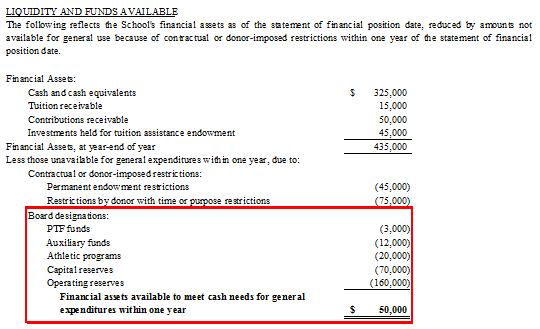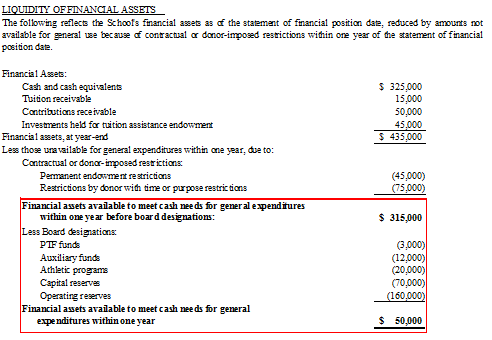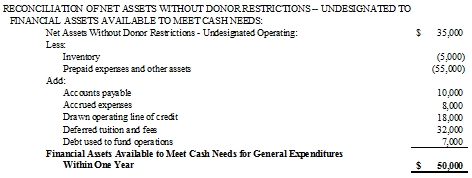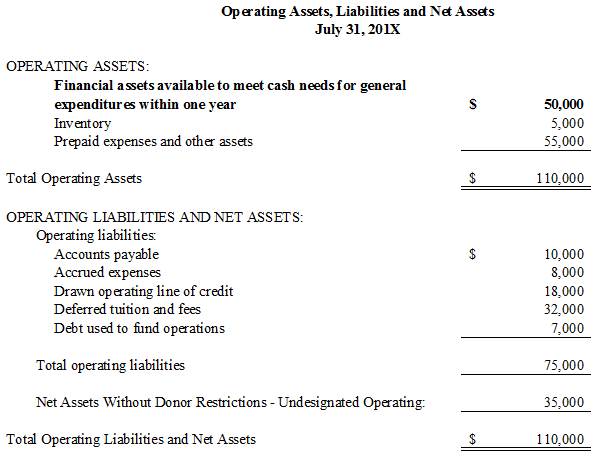Nonprofit Resources
ASU 2016-14 and Schools: Quantitative Liquidity and Availability Disclosures
An external financial statement is a financial statement provided to outside parties or those not related to the school, such as a bank. External financial statements must include “footnote disclosures” — certain information that explains policies, background details, facts, or additional numerical summaries about totals in the statements. Unlike a typical footnote located at the bottom of a page, financial statement footnotes are placed immediately after the financial statements to provide external users with more explanation and a better understanding of the school’s financial statements.
I have received a number of questions from Christian school clients about the additional disclosures related to liquidity and availability. This is an important consideration. For example, these disclosures could have an immediate implication for any school that gives its external financial statements to an outside lender for an upcoming loan application or renewal. The lender could believe that the school has fewer available funds for future loan payments than it actually has.
Let’s take a look at the requirements and what your school should consider as you plan for this significant implementation.
Reporting Operating Reserves
ASU 2016-14 requires certain quantitative information on either the face of the statement of financial position or in the notes to the financial statements. (Qualitative information is covered in part 2 of this article series.) It also requires additional qualitative information about the availability of a school’s financial assets at the Statement of Financial Position date to meet cash needs for general expenditures within one year of that date.
The availability of a financial asset may be affected by:
- Its nature (financial assets not convertible to cash within the next 12 months)
- External limits imposed by donors, grantors, laws, and contracts with others
- Internal limits imposed by governing board decisions (board-designated net assets)
Most schools maintain adequate financial assets to fund their external limits. In this situation, the biggest factor impacting many schools may be board-designated net assets — specifically “operating reserves.”
While not every school sets aside operating reserves, some do. As a best practice, these schools put away reserve funds for operations, capital needs, or other funds such as PTF, auxiliary, and athletics, and formally approve them as “board-designated funds.” These amounts are reported as a designated portion of net assets without donor restrictions on the Statement of Financial Position (or disclosed in the footnotes).
However, the ASU requires these net asset operating reserves, and all board-designated reserves, to be deducted in the quantitative information disclosure. See Figure 1 for an example.
Figure 1

As you can see, the ending total in this example is reduced by board designations, even though the school worked to build these designated reserves. This is because the ASU deducts these reserves representing amounts set aside for unexpected expenditures or shortfalls and related school activities.
Clarifying the Deduction
If the amount of financial assets available to meet cash needs is perceived as an amount that is less than desired because of your board designations, you may choose to explain this deduction in the qualitative section of the disclosure. But there’s a risk that some readers — including your board members, bankers, and grantors — won’t read the disclosure. And if they do, they may not fully understand it. For example, a lender may incorrectly conclude that you have fewer liquid reserves than you do, which might cause it to make a different decision on a financing renewal or terms of a loan. Or another outside party, such as a watchdog agency like Guidestar, may conclude that your school does not carry enough liquid reserves and is worse off financially than you really are. So what can you do to clarify this?
One possibility is to insert a subtotal for “Financial assets available to meet cash needs for general expenditures within one year prior to board designated reserves.” Below this subtotal would be a deduction of the “Board designated reserves” to get to the required total of “Financial assets available to meet cash needs for general expenditures within one year.” See Figure 2 for an example.
Figure 2

The qualitative paragraph could then refer to the subtotal line to make it easier for the reader to understand your school’s financial position.
Realistically, some readers of your external financial statements (potentially including watchdog agencies) may only look at or use the bottom line total because they assume it’s the best number to use for a true comparison. The irony is that a school that exercises a best practice of funding reserves and is disciplined in setting up and maintaining board-designated net assets could be misunderstood.
Reconciling Liquidity with Net Assets without Donor Restrictions
Many CapinCrouse Christian school clients also have questions about how this new liquidity amount reconciles with the net assets without donor restrictions undesignated amount (after net assets not invested in property and equipment are taken out). Figure 3 shows an example of this.
Figure 3

This reconciliation highlights several areas your school can manage or use near your fiscal year-end for this new footnote:
- Prepaid expenses – Consider making payments after year-end if an invoice is not due before then.
- Accounts payable – Consider making payments after year-end if an invoice is not due before then.
- Deferred tuition and fees – Determine the best time to send out billings in order to receive advance receipts of cash. These advance receipts are not current tuition and fees revenue, but would be reported as tuition and fees revenue in the next fiscal year and as a deferred tuition and fees liability at the year-end date.
- Debt used to fund operations – It’s typically better to use an operating line of credit unless your school needs a longer period of time to fund and pay off this type of operating debt.
- Drawn operating line of credit – We see many schools using this cash flow strategy. Some schools have no intention of using this line, but they can then disclose it in the qualitative paragraph to explain how the school intends to manage liquidity needs in the short-term.
- Deferred capital expenditures – You may want to defer making certain capital expenditures or incurring certain deferred maintenance expenses (if using operating funds) until the next fiscal year.
So what is another way to present this reconciliation to the board, management, and other users so they understand it? If you separate out just the operating component of assets, liabilities, and net assets, it becomes much easier to understand. Below in Figure 4 is a statement of operating assets, liabilities, and net assets that may be used to further explain this reconciliation. (Note: This statement is not intended to be included in the audited financial statements or related footnotes but rather as a management tool to assist users in understanding the reconciliation in the footnotes.)
Figure 4

It’s important to note that your school should not use the new disclosure amount to measure operating reserves.
Here are a few additional points to consider:
- As your annual budget increases, you may need to consider increasing the total amount of board-designated operating reserves accordingly.
- Your school cannot have the board designate funds unless you have adequate cash and general investments available to designate.
- ASU 2016-14 does not require comparative disclosures in the year of adoption so it is a single-year disclosure in the year of adoption.
If your school hasn’t considered how the liquidity disclosures will look in the footnotes, do it soon so you have time to consider these factors before the end of the fiscal year of the ASU adoption.
This article first appeared in the Association of Christian Schools International (ACSI) Legal/Legislative Update, Winter 2018.

Richard Lindley
Richard has managed audit, review, and compilation engagements for more than 20 years and provides church and other nonprofit consulting services in a variety of areas. He is a member of the firm’s Church and Denominational Team and helped draft the CapinCrouse Church Financial Health Index™ and CapinCrouse Church Checkup™ and related reports. Richard frequently authors church articles. He also serves as his church’s finance ministry leader.
